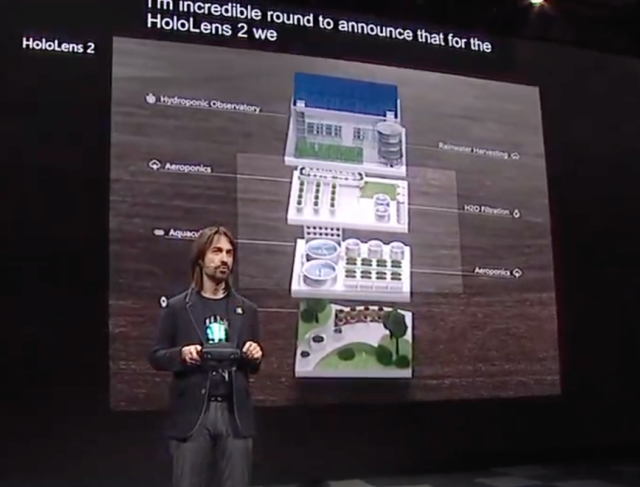As expected, Microsoft today launched HoloLens 2, the company's second generation augmented reality (AR) headset. The new hardware addresses what were probably the two biggest issues with the first generation device: the narrow field of view, and the comfort when wearing the device.
Microsoft says that the field of view has been doubled, without any reduction in visual quality. Both first and second generation devices aim to produce around 47 pixels per degree. This resolution is around the limit of human visual acuity (the Varjo VR-1 headset also aims at around this level, though it offers 60 pixels per degree), such that individual pixels can't be discerned, and curves look smooth even without extensive anti-aliasing. Each eye has about a 2,000×1,500 display, so while Microsoft doesn't seem to include an actual field of view measure on its spec sheet, that comes out at around a 53 degree (diagonal) field of view.

Enlarge / HoloLens 2 field of view, with first generation HoloLens field of view represented by the bright rectangle in the center.
Microsoft
Details of the new display system were lacking, but it appears to be a Microsoft-designed, custom-built MEMS (microelectromechanical system) display, with a tiny little electromechanical mirror used to bounce laser light around.
Comfort is also greatly improved. The original HoloLens was very front-heavy, with the optics, sensors, compute unit, and other heavy elements, all at the front of the device. The new HoloLens moves the integrated computer to the back of the device, and the front part is built of lightweight carbon fiber, making the headset much better balanced. It also looks much easier to put on and take off......
Microsoft says that the field of view has been doubled, without any reduction in visual quality. Both first and second generation devices aim to produce around 47 pixels per degree. This resolution is around the limit of human visual acuity (the Varjo VR-1 headset also aims at around this level, though it offers 60 pixels per degree), such that individual pixels can't be discerned, and curves look smooth even without extensive anti-aliasing. Each eye has about a 2,000×1,500 display, so while Microsoft doesn't seem to include an actual field of view measure on its spec sheet, that comes out at around a 53 degree (diagonal) field of view.

Enlarge / HoloLens 2 field of view, with first generation HoloLens field of view represented by the bright rectangle in the center.
Microsoft
Details of the new display system were lacking, but it appears to be a Microsoft-designed, custom-built MEMS (microelectromechanical system) display, with a tiny little electromechanical mirror used to bounce laser light around.
Comfort is also greatly improved. The original HoloLens was very front-heavy, with the optics, sensors, compute unit, and other heavy elements, all at the front of the device. The new HoloLens moves the integrated computer to the back of the device, and the front part is built of lightweight carbon fiber, making the headset much better balanced. It also looks much easier to put on and take off......
